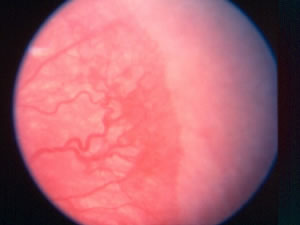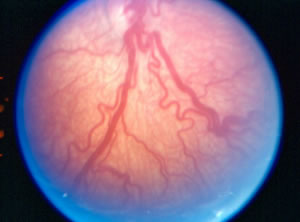Retinopathy of Prematurity (ROP)
What is retinopathy of prematurity (ROP)?
Retinopathy of prematurity (ROP) is a disorder of the retinal blood vessels that affects premature babies. It is most likely to affect babies born before about 30 weeks of pregancy and babies that weigh less than about 3 pounds. The blood vessels in the retina usually finish growing around the time a full-term baby is born. When a baby is born very prematurely, the blood vessels in the retina sometimes grow abnormally. This abnormal growth of retinal blood vessels can lead to traction on the retina and result in a retinal detachment (when the retina comes off the inner wall of the eye, similar to wallpaper coming off a wall) and loss of vision. Other problems can be associated with ROP, such as severe nearsightedness, strabismus (misalignment of the eyes) and glaucoma.
 On the right is a photograph of the sort of abnormal blood vessel growth that can occur in ROP. The photograph to the right shows retinal blood vessels growing from left to right. Running vertically through the photograph is the line of demarcation between retina with blood vessels (left) and retina that still has no blood vessels (right). Along that line, abnormal blood vessels are growing:
On the right is a photograph of the sort of abnormal blood vessel growth that can occur in ROP. The photograph to the right shows retinal blood vessels growing from left to right. Running vertically through the photograph is the line of demarcation between retina with blood vessels (left) and retina that still has no blood vessels (right). Along that line, abnormal blood vessels are growing:
How can the doctor tell if a baby has ROP?
Whenever a baby is born very prematurely, an ophthalmologist should examine the baby’s eyes periodically until the retinal blood vessels have finished growing. If ROP develops, the ophthalmologist can tell by looking into the baby’s eyes using specialized equipment. Sometimes the ROP is mild and does not need to be treated. If it becomes severe, it will require treatment in an attempt to prevent loss of vision.
How does the doctor decide whether treatment for ROP is needed?
The doctor looks for two things: abnormal blood vessel growth (shown above) and dilation of the retinal blood vessels. We describe severely dilated retinal vessels as “plus disease”. The decision on whether or not to begin treatment is based on the location of the abnormal blood vessels and the presence or absence of plus disease. In general, the more centrally located the abnormal blood vessels, the more likely treatment will be necessary — especially if there is plus disease. On the right is an example of plus disease:
How is ROP treated?
Laser remains the standard of care for ROP in most cases. A specialized laser mounted on a headset creates hundreds of tiny burns in the peripheral part of the retina. The baby is placed under heavy sedation or general anesthesia for treatment. The goal of laser treatment is to stop the abnormal growth of blood vessels and thereby prevent retinal detachment. The abnormal blood vessels, themselves, will resolve in a successfully treated eye. In more severe cases of ROP, the retina sometimes detaches despite laser treatment. In those cases, surgery can sometimes be done to reattach the retina. Two kinds of surgery are done: 1) Scleral buckling (placing a soft silicone band around the eye to indent the eye wall) and 2) vitrectomy (removal of the vitreous, the gel inside the eye). Both procedures are intended to relieve pulling forces that cause the retina to “tent up” and detach. In some eyes with ROP, even surgery is not enough to reattach the retina and all vision can be lost. Fortunately, due to modern techniques, complete blindness due to ROP is now uncommon.
Avastin, a medication that is injected into the eye to inhibit abnormal blood vessel growth, is also used in certain cases of ROP. Babies who receive Avastin need to be monitored closely for a longer period of time, as they might develop recurrent abnormal blood vessel growth at a relatively late stage in development requiring additional injections and/or laser.



